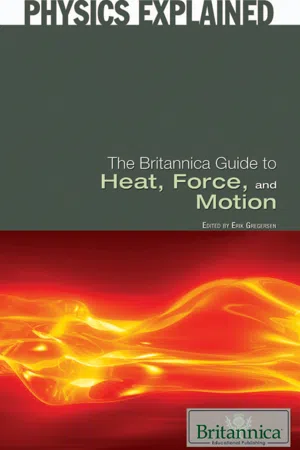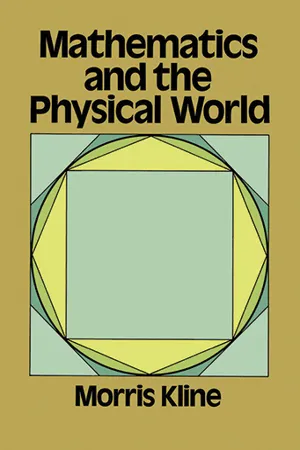Mathematics
Projectiles
Projectiles are objects that are launched into the air and follow a curved path due to the influence of gravity. In mathematics, the motion of projectiles can be modeled using equations that take into account the initial velocity, angle of launch, and gravitational acceleration. These equations can be used to predict the trajectory and landing point of a projectile.
Written by Perlego with AI-assistance
Related key terms
8 Key excerpts on "Projectiles"
- eBook - ePub
Sports Biomechanics
The Basics: Optimising Human Performance
- Prof. Anthony J. Blazevich(Author)
- 2017(Publication Date)
- Bloomsbury Sport(Publisher)
CHAPTER 3 PROJECTILE MOTIONBy the end of this chapter you should be able to:What is the optimum angle of trajectory or flight path (that is, the angle thrown relative to the ground) for a shot-putter aiming to throw the maximum distance? (Hint: not 45°.) What factors affect maximum throwing distance and to what degree?• List the factors that influence an object’s trajectory• Use the equations of projectile motion to calculate flight times, ranges and projection angles of Projectiles• Design a simple model to determine the influence of factors affecting projection range• Create a spreadsheet to speed up calculations to optimise athletic throwing performance• Complete a video analysis of a throw to optimise performanceProjectile motion refers to the motion of an object (for example a shot, ball or human body) projected at an angle into the air. Gravity and air resistance affect such objects, although in many cases air resistance is considered to be so small that it can be disregarded. A projected object can move at any angle between horizontal (0°) and vertical (90°) but gravity only acts on bodies moving with some vertical motion.Trajectory is influenced by the projection speed, the projection angle and the relative height of projection (that is, the vertical distance between the landing and release points; for example, in a baseball throw that lands on the ground, the vertical distance is the height above the ground from which the ball was released).FIG. 3.1 Tennis ball trajectory. Gravity accelerates the ball towards the ground at the same rate regardless of whether the tennis player leaves the ball to fall freely or hits it perfectly horizontally. However, the trajectory of the ball is different in these two circumstances.Projection speedThe distance a projectile covers, its range, is chiefly influenced by its projection speed. The faster the projection speed, the further the object will go. If an object is thrown through the air, the distance it travels before hitting the ground (its range) will be a function of horizontal velocity and flight time (that is, velocity × time, as you saw in Chapter 1 ). In Figure 3.1 - eBook - ePub
- Hiqmet Kamberaj(Author)
- 2021(Publication Date)
- De Gruyter(Publisher)
the x, y and z axes. 4.3 Projectile motion We often have observed a baseball in motion or any other object thrown into the air, such as an arrow shown in Fig. 4.5. By definition, this kind of movement is called projectile motion. Figure 4.5 An example of the projectile motion. v total represents the total velocity at any point of the projectile motion; v x and v y are, respectively, the x and y components. α is the angle formed by the direction of v total and x -direction, which varies from point to point along the trajectory. Assumptions of projectile motion In this motion, the ball follows a curved path, and its motion is simple to analyze if we make two assumptions: 1. The free-fall acceleration g is constant over the range of motion and is directed downward. 2. The effect of air resistance is negligible. Taking into account these assumptions, we will find in the following that the projectile motion’s path of a projectile (or the trajectory) is always a parabola. To show this, we consider the projectile motion in a reference frame such that the y -axis is vertical, and its positive direction is upward. Since the air resistance is neglected, we know that a y = − g (as in one-dimensional free fall) and that a x = 0. Also, the projectile is initially (t = 0) positioned at the origin (x i = y i = 0) with velocity v i, as shown in Fig. 4.6. The vector v i makes an angle θ i with the horizontal, where θ i is the initial angle (at the origin) between the direction of v i vector and the x -direction. Figure 4.6 Projectile motion of the baseball. From the definitions of the cosine and sinus functions, we obtain the x and y components of the initial velocity: (4.29) v x i = v i cos θ i v y i = v i sin θ i. Substituting the x component from eq. (4.29) into eq. (4.25) and taking x i = 0, a x = 0, we - eBook - ePub
- Britannica Educational Publishing, Erik Gregersen(Authors)
- 2010(Publication Date)
- Britannica Educational Publishing(Publisher)
Resonances are not uncommon in the world of familiar experience. For example, cars often rattle at certain engine speeds, and windows sometimes rattle when an airplane flies by. Resonance is particularly important in music. For example, the sound box of a violin does its job well if it has a natural frequency of oscillation that responds resonantly to each musical note. Very strong resonances to certain notes—called “wolf notes” by musicians—occur in cheap violins and are much to be avoided. Sometimes, a glass may be broken by a singer as a result of its resonant response to a particular musical note.MOTION OF A PARTICLE IN TWO OR MORE DIMENSIONS
More complex problems in mechanics involve a particle moving in two or more dimensions. Such problems include those of the pendulum and the circular orbit.PROJECTILE MOTIONGalileo pointed out with some detectable pride that none before him had realized that the curved path followed by a missile or projectile is a parabola. He had arrived at his conclusion by realizing that a body undergoing ballistic motion executes, quite independently, the motion of a freely falling body in the vertical direction and inertial motion in the horizontal direction. These considerations, and terms such as ballistic and projectile, apply to a body that, once launched, is acted upon by no force other than Earth’s gravity.Projectile motion may be thought of as an example of motion in space—that is to say, of three-dimensional motion rather than motion along a line, or one-dimensional motion. In a suitably defined system of Cartesian coordinates, the position of the projectile at any instant may be specified by giving the values of its three coordinates, x (t ), y (t ), and z (t ). By generally accepted convention, z (t ) is used to describe the vertical direction. To a very good approximation, the motion is confined to a single vertical plane, so that for any single projectile it is possible to choose a coordinate system such that the motion is two-dimensional [say, x (t ) and z (t )] rather than three-dimensional [x (t ), y (t ), and z (t - eBook - ePub
Doing Physics with Scientific Notebook
A Problem Solving Approach
- Joseph Gallant(Author)
- 2012(Publication Date)
- Wiley(Publisher)
Chapter 4Projectile Motion
The 1-dimensional kinematics of Chapter 2 allow us to describe horizontal or vertical motion in a straight line. Vectors allow us to analyze 2-dimensional objects. Now we combine the two and use vectors to describe 2-dimensional motion. A 2-d kinematics problem is really two 1-d kinematics problems and we use vectors to break the analysis into components.One example of 2-d motion is projectile motion, where an object is launched with an initial velocity and then is influenced only by gravity and air resistance. The object’s initial coordinates are x0 and y0 . Its initial velocity has magnitude v0 and direction θ0 above the horizontal.The horizontal component of the initial velocity is vox = v0 cos θ0 and the vertical component is voy = v0 sin θ0 . This unusual notation is due to a limitation of SNB: the engine can’t handle a double subscript unless the indices are either both numbers or both letters. So we’ll use vox instead of vox and voy instead of v0y. Here is a summary of the notation for the velocity and position of our projectile.Table 4.1With the equations of 1-dimensional kinematics and vectors, we can analyze projectile motion with and without air resistance. We will calculate the horizontal position x and the height y as functions of time directly and separately, and calculate the trajectory, the mathematical description of the path of the projectile that gives the projectile’s height as a function of horizontal position. We will also calculate how far the projectile travels horizontally before landing, how much time it spends in the air, and its maximum height.No Air Resistance
In the absence of air resistance, the only influence on the projectile is gravity. Near the Earth’s surface, the acceleration due to gravity is constant so we can use Eqs. (2.5) and (2.6) - No longer available |Learn more
MCAT Physics and Math Review 2024-2025
Online + Book
- (Author)
- 2023(Publication Date)
- Kaplan Test Prep(Publisher)
x-direction, one can find the horizontal distance traveled.Projectile Motion
Projectile motion is motion that follows a path along two dimensions. The velocities and accelerations in the two directions (usually horizontal and vertical) are independent of each other and must, accordingly, be analyzed separately. Objects in projectile motion on Earth, such as cannonballs, baseballs, or footballs, experience the force and acceleration of gravity only in the vertical direction (along the y-axis). This means that vywill change at the rate of g but vxwill remain constant. In fact, on the MCAT, you will generally be able to assume that the horizontal velocity, vx, will be constant because we usually assume that air resistance is negligible and, therefore, no measurable force is acting along the x-axis.KEY CONCEPT
Note that gravity is set in bold, indicating it has a vector value. Gravity is unique in that it is used as both a constant and as a vector in calculations. Though gravity is not always bolded, you should recall for Test Day that gravity has a direction.Example:A projectile is fired from ground level with an initial velocity of50and an initial angle of elevation of 37°, as shown below. Assumingm sg = – 10find the following: (Note: sin 37° = 0.6; cos 37° = 0.8)m,s 2- The projectile’s total time in flight
- The total horizontal distance traveled
Solution:- Let y equal the vertical displacement, and up be the positive direction. If we are going to use the vertical displacement and acceleration due to gravity (which is also in the y-direction), we must use the y-component of velocity in this part of the problem:
Now we can plug in:v=0 yv 0sin 37 ° =(( 0.6 ) = 3050)m sm sy =The height of the ball is zero at 0 seconds (its initial position) and 6 seconds (when it hits the ground again).t +v 0y0 =2a yt 230t +m s0 = 30 t - 52–10ms 2t 2t 25t 2= 30 tt 2= 6 t t = 0 s or 6 s
- eBook - ePub
Sports Math
An Introductory Course in the Mathematics of Sports Science and Sports Analytics
- Roland B. Minton(Author)
- 2016(Publication Date)
- Chapman and Hall/CRC(Publisher)
Chapter 1Projectile Motion
Introduction
Basketball star Stephen Curry launches a 3-point shot. As the ball traces its high arc toward the basket, fans rise to their feet in anticipation. Will it go in? Is it a little short? Similar tension accompanies a Jordan Spieth tee shot, an Andy Murray passing shot, a long football pass by Peyton Manning or Lionel Messi, or a long fly ball by Mike Trout. We will analyze the flights of balls in this chapter as we explore the area of physics known as mechanics.Along the way, we will answer such questions as: How does Blake Griffin hang in the air when dunking? What is the optimal angle to shoot a free throw? Why do golf balls have dimples? Does a knuckleball really dance? The answers are to be found in the fundamentals of physics.Figuring with Newton
Sir Isaac Newton (1643-1727) constructed a framework for the analysis of objects in motion. The second of his three Laws of Motion is the launching point for most of our investigations in this chapter. The shorthand version of Newton’s Second Law isF = mawhere F is the sum of all forces acting on an object, m is the object’s mass, and a is the acceleration of the object. One of the most remarkable aspects of Newton’s Second Law is that it can also be written as F = m a , where F and a appear in bold to indicate that they are multidimensional vector quantities. We will return to this form of the equation when we look at motion in two and three dimensions. The mass m is a scalar (real number) that is related to weight: for earthbound sports, weight is approximately equal to mass times the gravitational constant g .To keep it simple, let’s start with one-dimensional motion; vertical motion, to be precise. In this case, the object’s position can be tracked by its height h above some reference point (e.g., the ground). We define velocity as the rate of change of position with respect to time. At a constant speed, this means that velocity equals change in height divided by change in time:υ =Δ hΔ t - eBook - ePub
- Morris Kline(Author)
- 2012(Publication Date)
- Dover Publications(Publisher)
14: THE MOTION OF Projectiles I value the discovery of a single even insignificant truth more highly than all the argumentation on the highest questions which fails to reach a truth. —GALILEOBY analyzing motion along a straight line, whether it be of bodies falling straight down or sliding down inclined planes, Galileo discovered some fundamental physical principles, namely, the first two laws of motion. These laws are in themselves quantitative statements about velocity, force, mass, and acceleration. Moreover, by applying mathematical reasoning, with these laws and the axioms and theorems of mathematics as his basic facts, Galileo made some fundamental discoveries about motion. He was immensely encouraged to proceed with more difficult problems of motion, and in his Dialogues Concerning Two New Sciences, a book that had to be secretly transported to Holland for publication because the Church had banned publications by Galileo, he continued his investigations.His next subject, a new and pressing problem of his day, was the motion of Projectiles shot from cannon. He began this study with a somewhat simpler problem, the motion of an object thrown out horizontally but which as it moves out is pulled downward by the action of gravity. Interest in the motion of Projectiles has of course by no means diminished since Galileo’s time. Bombs dropped from airplanes are examples of objects thrown out horizontally and pulled downward by the action of gravity, and shells shot out from cannon are still a feature of the modern scene. In fact “progress” now enables us to send Projectiles thousands of miles whereas in the seventeenth century the range was limited to a few miles. Fortunately, just as diamonds are often found in the most disagreeable surroundings, so some of the brightest scientific ideas can be found in the study of the motion of bombs and shells.The paths of Projectiles are not straight lines but curved. Galileo therefore undertook the study of curvilinear motion. He made several capital discoveries which opened up the mathematical treatment of the subject. If a person rides on a train he shares the motion of the train; in fact, this is why he pays his fare. Likewise, objects on the earth share the motion of the earth and for this reason among others are not left behind by the rotation and revolution of the earth. All of this, of course, seems rather obvious as stated. But now suppose a passenger in a plane suddenly falls out of the plane. He still has the forward velocity that the plane imparted to him while he was a passenger and, were it not for air resistance and the downward pull of gravity, he would continue to travel forward at the same speed as the plane in accordance with Galileo’s first law of motion. This fact seems less credible despite the fact that it is verified for us almost daily. Suppose a person rides in an automobile at, say, 60 miles per hour (a trifling speed for modern man, who seems to enjoy going nowhere very fast), and then the brakes are suddenly applied. Of course the automobile’s velocity is rapidly decelerated but the passenger’s velocity is not. He continues to move forward and, if he ever recovers consciousness, will readily agree that he continued to move at at least 60 miles per hour. - eBook - ePub
- Jeremy Black(Author)
- 2017(Publication Date)
- Routledge(Publisher)
The basic differential equations of projectile motion in the atmosphere are nonlinear and do not have an exact solution. 17 Had these mathematicians succeeded in numerically integrating these equations or deriving linear approximations, their results would have remained worthless for gunnery. These equations also contain two numerical parameters that no one had accurately measured before Robins. These are the projectile’s initial or muzzle velocity and the air resistance (the aerodynamic drag acting on a projectile in flight). 18 Without valid numbers for these parameters, the differential equations can yield analytical solutions that may be mathematically interesting but remain worthless for making quantitative scientific predictions. Galileo’s idealized ballistics theory therefore remained the only useful ballistics theory for gunnery until the ballistics revolution. It had a similar appeal that basic neoclassical microeconomics theories have today: even though their direct applicability is limited, the rational thinking these theories stimulate is very powerful. In the early 1950s, A. Rupert Hall made an influential argument that ballistics was useless for gunnery before the 19th century. One reason, he claimed, was that smoothbore artillery was too inaccurate to make a mathematical prediction of its performance possible. He wrote that “the gun itself was so inconsistent in its behavior that great accuracy in preliminary work, even in the lay of the gun itself, was labour in vain.” 19 Hall concluded that “it was the engineering ingenuity of the nineteenth century, not the progressive elaboration of dynamical theories originating with Galileo and developed by Newton, that was responsible for the revolution which then, at last occurred, with the introduction of scientific ballistics to gunnery.” 20 This idea is flawed regarding both the timing and the cause of the ballistics revolution
Index pages curate the most relevant extracts from our library of academic textbooks. They’ve been created using an in-house natural language model (NLM), each adding context and meaning to key research topics.







